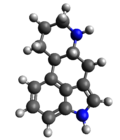Ergoline
|
|||
| Clinical data | |||
|---|---|---|---|
| ATC code | none | ||
| Identifiers | |||
|
|||
| CAS Number |
478-88-6 |
||
| PubChem (CID) | 6857537 | ||
| ChemSpider |
5256873 |
||
| ChEBI |
CHEBI:38484 |
||
| Chemical and physical data | |||
| Formula | C14H16N2 | ||
| Molar mass | 212.29g/mol | ||
| 3D model (Jmol) | Interactive image | ||
|
|||
|
|||
Ergoline is a chemical compound whose structural skeleton is contained in a diverse range of alkaloids. Ergoline derivatives are used clinically for the purpose of vasoconstriction (5-HT1 receptor agonists—ergotamine) and in the treatment and alleviation of migraines (used with caffeine) and Parkinson's disease. Some ergoline alkaloids found in ergot fungi are implicated in the condition ergotism, which causes convulsive and gangrenous symptoms. Others are psychedelic substances, including LSD and some alkaloids in Argyreia nervosa, Ipomoea tricolor and related species.
In addition to the naturally occurring ergonovine (used as an ) and ergotamine (a vasoconstrictor used to control migraine), synthetic derivatives of importance are the oxytocic methergine, the anti-migraine drugs dihydroergotamine and methysergide, hydergine (a mixture of dihydroergotoxine mesylates, INN: ergoline mesylates), and bromocriptine, used for numerous purposes including treatment of Parkinson's disease. Newer synthetic ergolines used for Parkinson's disease include pergolide and lisuride.
...
Wikipedia


